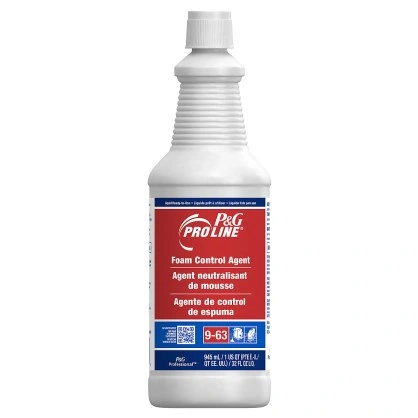Common Challenges in Foam Control and How to Overcome Them Efficiently
Common Challenges in Foam Control and How to Overcome Them Efficiently
Blog Article
Effective Methods for Attaining Optimal Foam Control in Chemical Production
Effective foam control is a vital element of chemical manufacturing that can considerably affect production effectiveness and product quality. By understanding the devices of foam development and selecting appropriate anti-foaming representatives, makers can take aggressive steps to mitigate too much foam.
Understanding Foam Development

Surfactants, or surface-active agents, reduce the surface area tension of the liquid, facilitating bubble security and promoting foam generation. Additionally, anxiety or mixing procedures can improve bubble formation, commonly aggravating foam concerns. The attributes of the liquid tool, including thickness and density, more impact foam behavior; as an example, more thick fluids often tend to trap air extra effectively, bring about enhanced foam security.
Comprehending these basic aspects of foam formation is essential for effective foam control in chemical production. By identifying the conditions that promote foam growth, manufacturers can execute targeted approaches to mitigate its negative impacts, thus optimizing production procedures and guaranteeing consistent product high quality. This foundational understanding is essential before checking out details approaches for controlling foam in industrial settings.
Choice of Anti-Foaming Representatives
When choosing anti-foaming agents, it is vital to take into consideration the details characteristics of the chemical process and the type of foam being generated (Foam Control). Various elements influence the efficiency of an anti-foaming agent, including its chemical structure, temperature level stability, and compatibility with other process materials
Silicone-based anti-foams are widely utilized due to their high effectiveness and wide temperature array. They function by decreasing surface tension, permitting the foam bubbles to coalesce and break more easily. They may not be ideal for all applications, specifically those including sensitive formulas where silicone contamination is an issue.
On the various other hand, non-silicone representatives, such as mineral oils or natural substances, can be helpful in particular scenarios, specifically when silicone deposits are unfavorable. These agents have a tendency to be less reliable at greater temperatures yet can give efficient foam control in other problems.
Furthermore, understanding the foam's beginning-- whether it develops from aeration, frustration, or chemical reactions-- overviews the choice procedure. Examining under actual operating problems is essential to make sure that the selected anti-foaming representative satisfies the one-of-a-kind demands of the chemical manufacturing procedure successfully.
Process Optimization Techniques
Efficient foam control is a vital element of maximizing chemical manufacturing procedures. By fine-tuning these criteria, operators can decrease disturbance, thus lessening foam development throughout mixing.
Furthermore, managing temperature level and stress within the system can significantly affect foam generation. Reducing the temperature level might reduce the volatility of specific parts, leading to decreased foam. Preserving ideal pressure levels assists in reducing extreme gas release, which contributes to foam stability.
Another effective approach is the tactical addition of anti-foaming agents at critical points of the process. Careful timing and dose can guarantee that these agents efficiently suppress foam without disrupting various other procedure criteria.
Moreover, integrating a methodical examination of raw material properties can aid recognize naturally foaming substances, permitting for preemptive actions. Carrying out regular audits and procedure evaluations can reveal inadequacies and locations for enhancement, making it possible for continuous optimization of foam control strategies.
Surveillance and Control Solution
Monitoring and control systems play an important role in keeping optimal foam monitoring throughout the chemical manufacturing procedure. These systems are necessary for real-time observation and adjustment of foam levels, guaranteeing that manufacturing effectiveness is made best use of while lessening disruptions triggered by extreme foam formation.
Advanced sensing units and instrumentation are employed to identify foam density and elevation, providing important data that educates control algorithms. This data-driven method enables the timely application of antifoaming representatives, ensuring that foam levels continue to be within acceptable limitations. By incorporating tracking systems with procedure control software application, suppliers can carry out automated actions to foam fluctuations, minimizing the more helpful hints need for hands-on treatment and boosting operational consistency.
In addition, the integration of artificial intelligence and predictive analytics right into monitoring systems can assist in proactive foam management. By examining historical foam data and operational specifications, these systems can anticipate foam generation patterns and advise preemptive measures. Regular calibration and maintenance of tracking tools are vital to guarantee precision and integrity in foam detection.
Ultimately, efficient tracking and control systems are essential for maximizing foam control, promoting safety, and improving general efficiency in chemical production settings.

Study and Ideal Practices
Real-world applications of surveillance and control systems highlight the relevance of foam management in chemical manufacturing. A noteworthy case research study entails a large-scale pharmaceutical producer that executed an automated foam detection system.
Another exemplary situation comes from a petrochemical company that embraced a combination my review here of antifoam agents and process optimization methods. By assessing foam generation patterns, the company tailored its antifoam dosage, leading to a 25% reduction in chemical usage and significant cost financial savings. This targeted approach not just decreased foam disturbance but also boosted the general stability of the manufacturing procedure.

Verdict
Finally, accomplishing optimum foam control in chemical production necessitates a thorough strategy including the selection of ideal anti-foaming agents, application of procedure optimization strategies, and the integration of advanced monitoring systems. Regular audits and training even more boost the efficiency of these techniques, promoting a culture of continuous improvement. By attending to foam formation proactively, makers can significantly improve manufacturing effectiveness and product high quality, inevitably adding to even more sustainable and use this link economical operations.
By comprehending the mechanisms of foam formation and picking appropriate anti-foaming representatives, makers can take proactive steps to alleviate excessive foam. The features of the fluid medium, consisting of thickness and thickness, more influence foam habits; for instance, even more viscous liquids often tend to trap air a lot more effectively, leading to enhanced foam stability.
Understanding these fundamental facets of foam formation is crucial for effective foam control in chemical manufacturing. By assessing historical foam data and operational criteria, these systems can anticipate foam generation patterns and recommend preemptive actions. Foam Control. Regular audits of foam control gauges guarantee that processes continue to be maximized, while promoting a culture of positive foam administration can lead to sustainable renovations throughout the production spectrum
Report this page